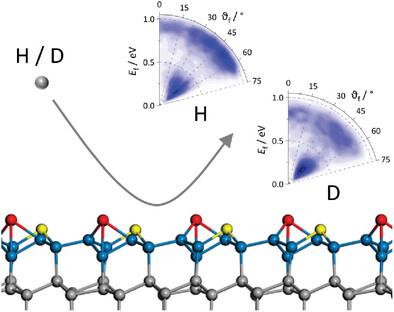Isotope effect suggests site‐specific nonadiabaticity on Ge(111)c(2×8)
IF 3.1
Q2 MULTIDISCIPLINARY SCIENCES
引用次数: 0
Abstract
Abstract Energy transferred in atom‐surface collisions typically depends strongly on projectile mass, an effect that can be experimentally detected by isotopic substitution. In this work, we present measurements of inelastic H and D atom scattering from a semiconducting Ge(111) c (2×8) surface exhibiting two scattering channels. The first channel shows the expected isotope effect and is quantitatively reproduced by electronically adiabatic molecular dynamics simulations. The second channel involves electronic excitations of the solid and, surprisingly, exhibits almost no isotope effect. We attribute these observations to scattering dynamics, wherein the likelihood of electronic excitation varies with the impact site engaged in the interaction. Key Points Previous work revealed that H atoms with sufficient translational energy can excite electrons over the band gap of a semiconductor in a surface collision. We studied the isotope effect of the energy transfer by H/D substitution and performed band structure calculations to elucidate the underlying excitation mechanism. Our results suggest a site‐specific mechanism that requires the atom to hit a specific surface site to excite an electron‐hole pair.

同位素效应表明Ge(111)c的定点非绝热性(2×8)
原子-表面碰撞中的能量转移通常强烈依赖于抛射物的质量,这种效应可以通过同位素取代实验检测到。在这项工作中,我们提出了从半导体Ge(111) c (2×8)表面显示两个散射通道的非弹性H和D原子散射的测量。第一个通道显示了预期的同位素效应,并通过电子绝热分子动力学模拟定量再现。第二个通道涉及固体的电子激发,令人惊讶的是,几乎没有表现出同位素效应。我们将这些观察结果归因于散射动力学,其中电子激发的可能性随参与相互作用的撞击地点而变化。先前的研究表明,具有足够平动能的氢原子可以在表面碰撞中激发半导体带隙上的电子。我们通过H/D取代研究了能量转移的同位素效应,并进行了能带结构计算来阐明潜在的激发机制。我们的研究结果表明了一种位点特异性机制,需要原子撞击特定的表面位点来激发电子空穴对。
本文章由计算机程序翻译,如有差异,请以英文原文为准。
求助全文
约1分钟内获得全文
求助全文

 求助内容:
求助内容: 应助结果提醒方式:
应助结果提醒方式:


